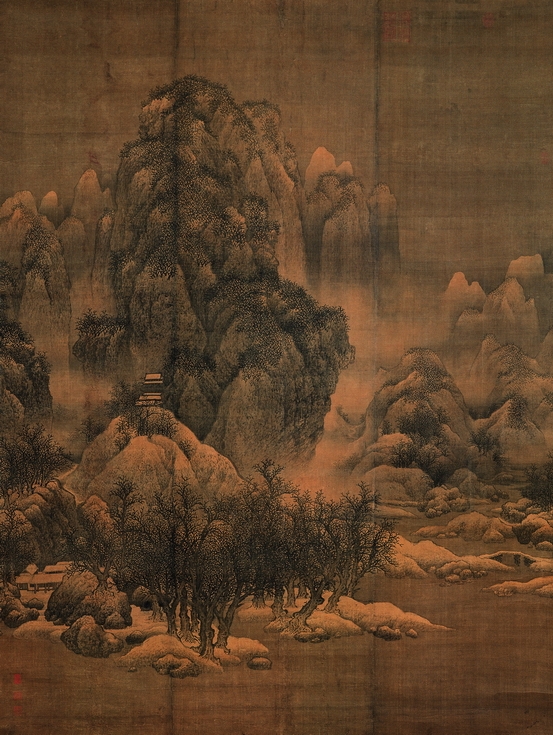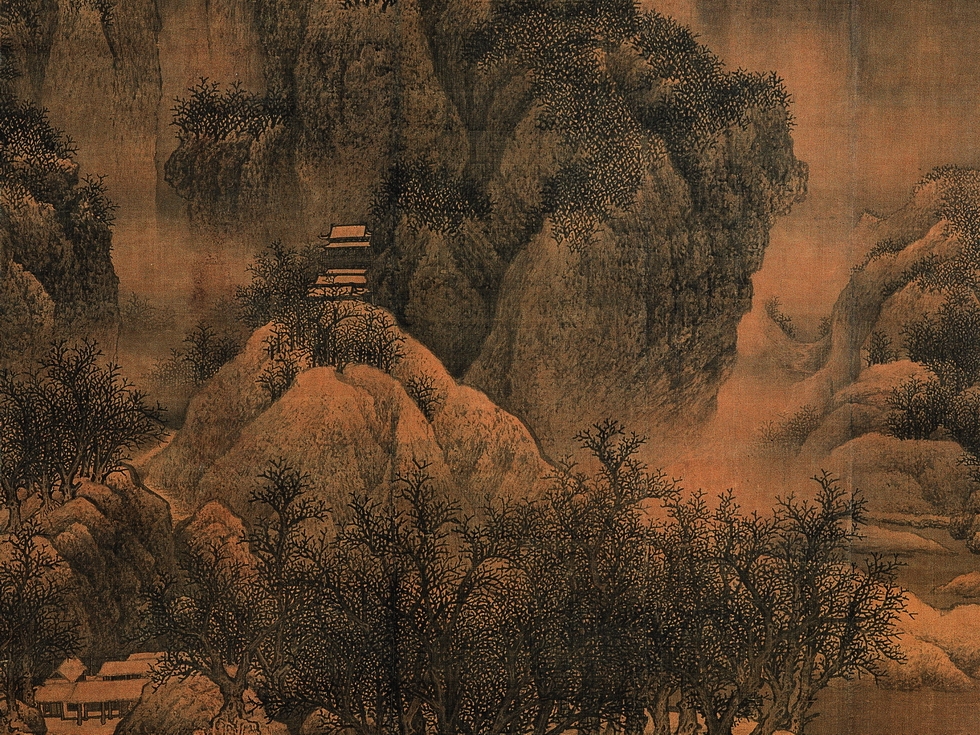宋 范宽 雪景寒林图轴
宋(960—1279)
绢本 设色
纵193.5厘米 横160.3厘米
宋代画家范宽所作《雪景寒林图》是天津博物馆的镇馆之宝之一。该图为三拼绢的大幅画作。白雪皑皑中,雪峰屏立,山势高耸,山麓水际边密林重重。深谷寒林间,萧寺掩映,流水无波,峰峦沟壑间云气万千,真实生动地表现了秦陇山川雪后的磅礴气象。全画布置严整,笔墨浓重润泽,层次分明而浑然一体,皴擦、渲染并用,尽显山石和枯木锐枝的质感,被公认为范宽的杰作。画面前景的树干中,隐约可见“臣范宽制”的署款,《宣和画谱》中记《雪景寒林图》曾收于宫廷御府,这很可能是范宽专为宫廷而作,也必是精心之作。
范宽,字中立,华原(陕西耀县)人。画史记载:他性情宽厚,人呼之为“宽”,遂以范宽自名。《图画见闻志》中言曰“天圣中犹在”,天圣是宋仁宗1023到1031年间的年号,说明范宽生活于北宋前期,距今已990余年。画史记载,范宽喜画山水,学画中感叹曰:“与其师人,不若师诸造化”(《图绘宝鉴》)。“于是舍其旧习,卜居于终南太华岩隈林麓之间,而览其云烟惨淡,风月阴霁难状之景,默与神遇……故天下皆称宽善与山传神”(《宣和画谱》)。他多画峰峦浑厚、雄博苍劲的关中山川。元代汤垕《画鉴》曰其“得山之骨法”,且“宋世山水超越唐世者,李成、董源、范宽三人而已”,为“照耀古今”的北宋山水画三大家之一。
《雪景寒林图》历经清代著名收藏家梁清标、安岐鉴藏,乾隆时收入内府,存于圆明园。1860年英法联军掠圆明园时曾流落民间,后被工部右侍郎张翼购得。从此张翼、张叔诚父子两代对其倍加珍爱。《雪景寒林图》至今保存完好,除画绢自然变色外,几乎没有破损残缺,无疑更提升了艺术和史料价值。经过近千年的流转,《雪景寒林图》是现存于大陆的唯一的范宽作品。历代藏家对其收藏,能目睹其精彩的人寥寥可数。连自己的家人都秘不展示的张叔诚先生,于1981年毅然将其捐给天津艺术博物馆,使得千千万万的观众不分尊卑贫富都有机会欣赏这旷世珍品。
Snow-Covered Scene and Cold Forest
Fan Kuan
Song dynasty(960-1279)
Height 193.5cm, Width 160.3cm
The Northern Song dynasty was a peak in the development of traditional landscape painting, producing the historically renowned Three Masters of Landscape, one of whom was the Shaanxi painter Fan Kuan. His Northern Landscape school depictions of the majesty and grandeur of the northern landscapes had a deep influence on subsequent generations of artists. This monumental hanging scroll is imbued with a sense of lofty grandeur, painted across three pieces of silk. It is one of the few surviving works by Fan Kuan. The dense composition and intense, heavy brush strokes render a lively depiction of the threatening cold, felt after a snowfall on the rivers and peaks of the Qinling and Longshan mountains. The intensity of the scene feels pregnant with potential. This is an extremely rare and valuable piece.
While the exact dates of Fan Kuan’s birth and death are not clear, it is known that he lived during the Northern Song period. His style name was Zhong Li, and he was a native of Huayuan (modern day Yao County) in Shaanxi. He was a skilled painter of landscapes, initially studying under Li Cheng and Jing Hao. However, he later came to realise that “nature was a superior teacher to man” and took up residence on Mount Taihua in the Zhongnan range. Here Fan Kuan immersed himself in the grandeur of the landscape through a long period of observation and painting from life. Critics have said his landscapes “obtained the bones”, meaning that he captured the essential form of the mountain.






 电话:022-83883000
电话:022-83883000 传真:022-83883088
传真:022-83883088 地址:天津市河西区平江道62号
地址:天津市河西区平江道62号